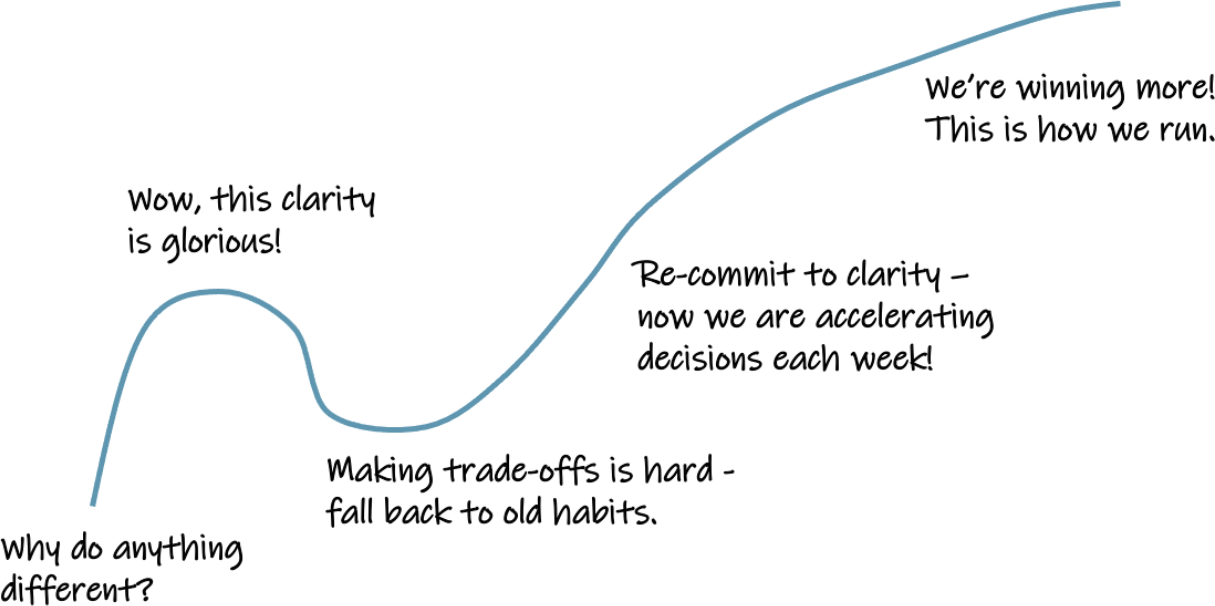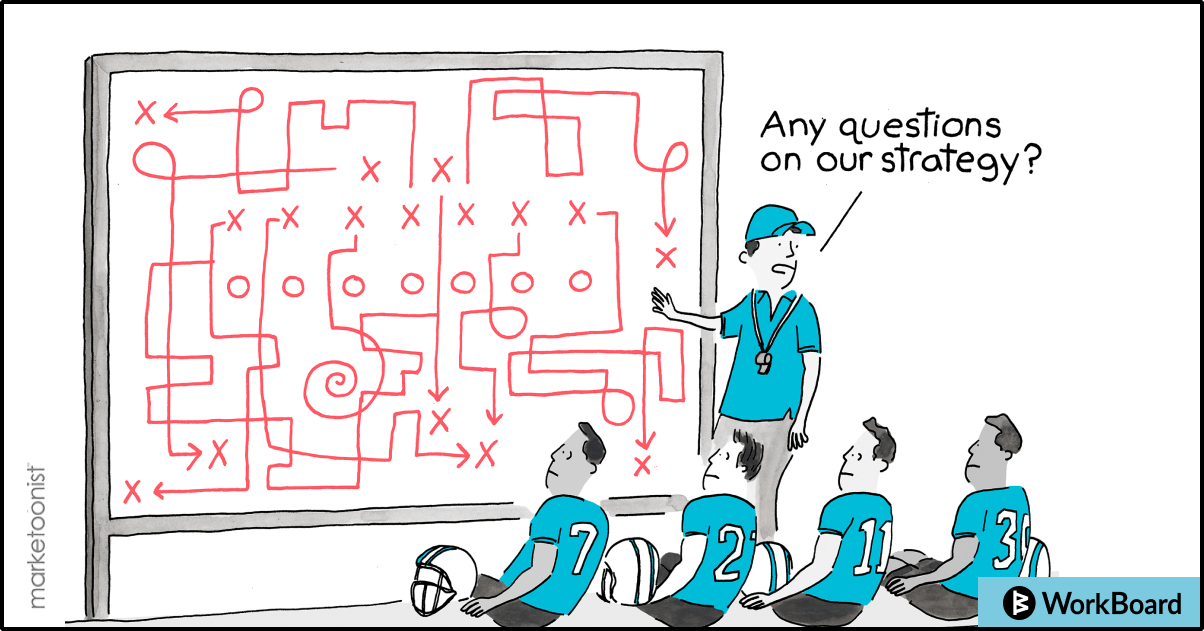OKRs are a framework for strategy execution – they are how you break a long-range strategy into the elements you want to achieve this year and this quarter, adjust course throughout the year as the world changes, and maximize the results you can achieve given the resources you have (this drives your growth rate and profit margin). Alignment and accountability are the job of senior leaders and team managers; the OKR technique and WorkBoard are powerful levers in their effectiveness.
In adopting this strategy execution framework, the people driving the introduction and operating cycle sometimes assume everyone knows the true purpose, so for convenience, they default to jargon and acronyms. This hides the purpose of the framework and platform, stripping meaning from the message. Or, worse, they forget the purpose themselves and get too enamored with executing on the process rather than executing on the strategy.
When our communications efforts sound more like process nags than business accelerators, we sabotage the very outcomes we seek to drive. Process rejection undermines strategy execution. It’s helpful and telling to take common rejection statements and look at them with the essence of strategy execution front and center. Doing so highlights the hazard of communication shortcuts and what underpins the rejection statements themselves:
“We don’t need to do OKRs – they’re unnecessary overhead.”
Translation: We don’t need to take the time to communicate our intended outcomes within our teams or across the organization, nor do we need to be transparent about whether we are achieving those outcomes. We can easily focus on and achieve the right things without defining, writing, or measuring them.
“We only need to do OKRs at the top on the few most important things we’re changing.”
Translation: All the other teams and managers have another equally effective way of defining what they’ll focus on, what they’ll achieve, and how they’ll be accountable for it. It’s just the leadership team that needs the “crutch” of documenting and measuring results – everyone else has enough clarity, focus, and accountability already.
“We are going to let people decide if they want to do OKRs or not.”
Translation: People can opt in to our strategy execution framework and decide if they want to align on outcomes, be transparent about them, or be accountable for them. Alignment, accountability and transparency for outcomes is something people can opt out of.
“We don’t want to introduce too much change at once, so we are going to slow roll it.”
Translation I don’t mind the absence of transparency now and it’s fine if most of the organization operates with a loose understanding of the outcomes we need to drive this quarter. Helping people prioritize efforts based on the value they create and gain confidence they’re doing the most important work would not be helpful at this point – we have too many priorities to prioritize.
“People have OKR fatigue.”
Translation: Taking the time to get clarity isn’t valuable and it’s hard for people – they get all tripped up trying to think through the important outcomes. And being accountable for the gap between promises and results is really exhausting for people. The psychic damage from constantly changing external events isn’t the root cause of fatigue; it’s this quarterly cycle of assessing and adjusting to change that is really wearing people down. Besides, we’re doing well now so let’s cancel clarity and accountability because they’re too much work.

“I don’t need to do OKRs – I run my part of the business well already.”
Translation: I don’t want to be involved in alignment outside my own day-to-day focus and don’t need to be transparent. I am not interested in identifying or resolving inter-dependencies in a systematic way – I’d rather do that in meetings and by reacting to issues as they arise.
“OKRs didn’t work for us.”
Translation: When we asked people to think about, write and measure the outcomes they were driving for the business, it was too difficult for them to frame things as results. We weren’t that clear about our strategy either, so getting people to align on it was difficult. We had everything in Excel and PowerPoint so we couldn’t see or really use the data for business decisions either, so after 2 or 3 quarters, we just stopped. Now we use a series of meetings, decks and dashboards, and ops reviews to drive attention and focus where it’s needed.
“Our leadership team doesn’t like OKRs.”
One Translation: They prefer not to have one framework for defining our strategic priorities and the measures of success each quarter – it’s easier to execute on our strategies when we don’t have a consistent structure for putting the strategy into motion and measuring our progress. It was just too “heavy” to have the trade off and tie off conversations each quarter to really get aligned and, besides, everyone had to learn to speak one language for describing results vs each using a different way to describe where their team’s efforts were going.
Second Translation: The objectives and measure of results we aligned on were never used in decision-making or driving the business – we would agree and document, then focus elsewhere, so it was all just a waste of time. The target results we agreed on would just sit in spreadsheets, people never shared their progress toward those results (or lack of it), and management never looked at the results or discussed them in operational meetings. It was like a giant documentation exercise that never helped us drive the business forward.
Avoid losing sight of your business strategy amidst jargon and indirection by making a few simple changes in how you communicate. Great communications drive success in any meaningful change, and at the center of a strong multi-pronged, multi-channel communications playbook are two non-negotiable pillars:
We have a great strategy; now we need to execute on it fast and well.
One line
This will help us align our efforts to strategy outcomes, understand and measure our progress more efficiently, and adapt as the world changes so we execute well on our bold strategy.
One paragraph
As we navigate more frequent change and volatility, our ability to quickly adapt to change has become more important.
As resources become more constrained in the current economy, our ability to prioritize and focus on what's most important becomes crucial.
Two supporting facts
We want everyone to have clarity on the most important work and the confidence to prioritize and focus on it.
One line
This will give teams the ability to crystallize the outcomes that matter most in a quarter and clarity on what success looks like within their team, and the visibility to see across the org to resolve dependencies and purposefully collaborate with other teams more effectively.
One paragraph
As resources become more constrained and the pace of change increases, it can be overwhelming.
It can feel as though we have too many priorities which makes decisions hard and meaningful progress slow, and that change is random rather than a part of the cadence of the business.
Two supporting facts
With those two pillars anchoring all your communications, people can connect to the reason you’re asking them to participate. While it’s convenient to short cut all that to “do OKRs” the short cut won’t save you time – it will create friction and undermine what you’re trying to achieve.
Use these options to keep purpose front and center.
| Instead of… | Use this… |
|---|---|
| Do OKRs | Get aligned on outcomes and how we measure success this quarter |
| Update KRs | Be transparent about progress so we can make good decisions and manage dependencies |
| The OKR process | Our strategy execution cycle |
| OKRs | Align on outcomes |
| Cascade | Align results |

Like it? Share it with your network!